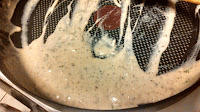Roasted Chicken is one of the most
versatile foods. It can be dressed up for formal affairs, yet it is never too
stuffy, pardon the pun, for a simple social gathering. Although the general
preparation is simple, there are several ways to veer into the land of, well,
not so tasty chicken. The primary
culprit is dryness, followed by blandness, over seasoning to the point you lose
any sense you're eating chicken, and lastly undercooking. This preparation
seeks to solve all, but the last one. That is because doneness is measured by
temperature, and not always time. Roughly a chicken's internal temperature
should reach 180 degrees Fahrenheit. Cooking times will vary depending on the
size of the chicken, baking temperature, and type of oven. Normally, however, a
good rule of thumb for planning is about 20-25 minutes per pound.
When combatting dryness two things are essential: a moist
stuffing, and resting. The stuffing here is designed to release moisture to
enhance the chicken. This is in contrast
to bread and rice based stuffing that is designed to absorb moisture from the
chicken. More important than the stuffing is the resting. Once the chicken reaches doneness, take it
out of the oven and let it rest on the counter for 30 minutes. Avoid any picking,
early slicing, or anything that will release moisture. It may be difficult if you're hungry, but
this will allow the meat to hold on to moisture.
On to blandness and over seasoning, they really are
different faces on the same coin. While neither one is ideal, the latter is
very difficult, if not impossible, to fix after basking. Under seasoning is
usually the result of a fear of over seasoning, however, fear be gone. Just
remember salt is not your enemy, but it is to be respected. This preparation
uses 1½ teaspoons of salt divided between the interior and the exterior. Pepper and other seasonings may be added,
but a good indicator is smell. A raw chicken should smell like chicken, even
after it's seasoned. If it doesn't, then it will not taste like chicken. A good tip is that prior to baking most excess
seasonings can be rinsed off.
1 6 pound roasting hen
1 small onion
½ medium Golden
Delicious apple
2 cloves of garlic
1½ teaspoon salt (divided)
2 teaspoon black
pepper (divided)
2 teaspoons poultry
seasoning (divided)
1 teaspoon paprika
2 teaspoons of olive
oil.
Step One: Oven and Settings
Preheat the oven to 350 degrees Fahrenheit, if using a
convection oven please consult your owners manual regarding convection oven
conversion.
Remove the chicken from its packaging, and then remove the
organ packet or the organs from the cavity. Rinse the chicken inside and out.
Pat the chicken dry with paper towels and place on a cutting board. Using poultry shears trim off any access skin
and fat.
Step Three: Season and Stuff
Step Four: Bake
Transfer the seasoned and stuffed chicken to a baking dish
preferably one with a rack to avoid the
Step Five: Rest
Once the chicken is done, remove it from the oven and let it
rest for 30 minutes prior to trimming.


















